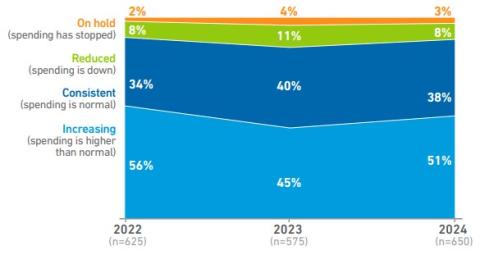The 14th edition of the Uptime Institute Global Data Center Survey highlights the experiences and strategies of vendors, product suppliers, engineering firms, and consultants in the areas of data center spending, customer challenges, supply chains,…
filters
Explore All Topics
Data center operators face expanding information and key performance indicator reporting requirements. Standard accounting practices and data exchange processes will help enable the efficient exchange of information.
Preliminary calculations by Uptime Intelligence suggest the initial impact of generative AI on global data center power use is low — but it will rise quickly as adoption increases. How far generative AI will go remains unclear.
This update examines the differences between machine learning and traditional software development and outlines the terms and definitions that may help digital infrastructure operators to understand the role and impact of AI.
In this Webinar, the Uptime Intelligence team looks beyond the obvious trends of 2024 and identifies some of the latest developments and their associated limitations.
The industry is touting AI as a highly useful tool for data center operations. In this Webinar, Uptime executives discuss the most appropriate AI systems for data center controls and efficiency, along with what works best - and why.
Pressure to improve data center efficiency and sustainability is driving interest in artificial intelligence (AI) technologies. Several startups aim to deliver new capabilities in IT power management and cooling optimization.
Uptime Intelligence looks beyond the more obvious trends of 2024 and identifies some challenging issues. Strong IT demand, high-density IT systems and tough sustainability requirements will drive a new wave of investment.
A new approach to data center management, proposed by data scientists and statisticians, looks to augment the functionality of tools like BMS and DCIM software by focusing on data, not equipment.
Results from the Uptime Institute IT and Power Efficiency Survey 2023 suggest that many organizations may struggle to meet regulatory requirements for energy, carbon and IT life cycle tracking.
The propensity to confidently give false information likely disqualifies generative AI from operational decision-making. However, this type of AI, with human supervision, could enhance other aspects of data center management.
This session describes the questions organizations need to answer around technology roadmaps, market growth and workload requirements to effectively plan the data center builds of the near future.
Findings from the latest Uptime Institute Global Data Center Survey show for the first time that the proportion of IT workloads hosted in on-premises data centers now represents slightly less than half of the total enterprise footprint.
Unpredictable costs and “bill shocks” are a growing problem for organizations running their applications and workloads in the public cloud. FinOps could help enterprises analyze, report and optimize cloud and other IT costs.
The Uptime Institute Global Data Center Survey 2023 shows that trust in artificial intelligence as a tool capable of making operational decisions has fallen sharply year on year. What is causing this reaction?
 Anthony Sbarra
Anthony Sbarra
 Laurie Williams
Laurie Williams

 Jay Dietrich
Jay Dietrich

 Andy Lawrence
Andy Lawrence
 Daniel Bizo
Daniel Bizo

 Max Smolaks
Max Smolaks

 Jacqueline Davis
Jacqueline Davis
 John O'Brien
John O'Brien
 Douglas Donnellan
Douglas Donnellan

 Todd Traver
Todd Traver
 Amro Almashharawi
Amro Almashharawi






 Antonio Piraino
Antonio Piraino



